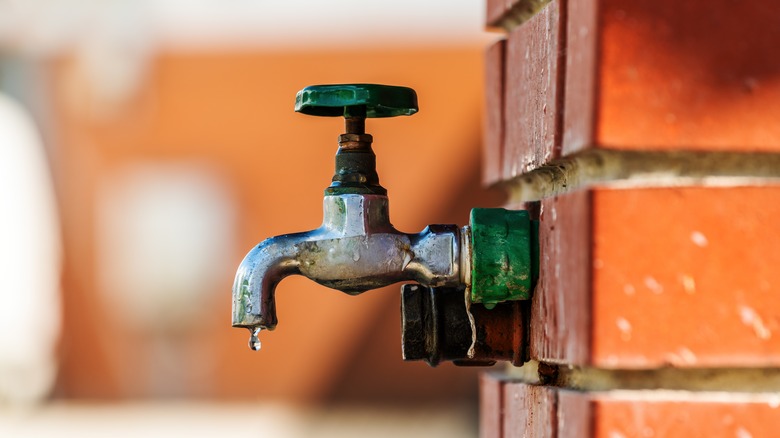Fix That Leaky Outdoor Faucet Without Calling The Pros, Here's How
We may receive a commission on purchases made from links.
Is your outdoor faucet leaking? Water leaks in and around the house should not be ignored. Not only is the trickling water a nuisance in the yard, it also adds to your home's utility costs, which is why fixing or replacing the leaky hose bib should be your priority. Before you start looking up local plumbers, though, know this: Repairing a hose bib that's sprung a leak is a rudimentary DIY task that shouldn't take you more than 10 minutes. The only thing you need to do is replace the rubber washer inside the housing, and the hose bib should work like it's brand new.
The rubber washer inside the hose bib's housing is an essential component that blocks water from trickling through the faucet when the tap is turned to the off position. Over time, this rubber part wears off. If it's really old, it may become completely flat and useless, to the point where the pressurized water doesn't have a reliable obstacle to keep it from dripping out. Worn-out washers are the main reason behind leaky outdoor faucets, and luckily, they're easy to replace. Before you begin the replacement, equip yourself with a pipe wrench, an adjustable wrench, and a rubber washer kit like this one from The Home Depot. We explain the repair procedure below.
DIY steps for fixing a leaky faucet quickly
Start by shutting off the water supply to your home, or to the hose bib if there is a separate valve for it. Then, find the nut that secures the tap to the faucet housing. Now, different types of outdoor water spigots will have the nut in a different location, but it should be somewhere between the tap and the housing. It shouldn't take you long to find. Next, clamp the housing with a pipe wrench with your non-dominant hand. Now, you can turn the nut counterclockwise with an adjustable wrench. After a few turns, the nut and the tap assembly should be easy to pull out of the housing.
Once the concealed part of the assembly slides out of the housing, you'll notice that it resembles a shaft with a round rubber washer at its end — now you've found the source of the water leak. The washer is normally secured to the shaft with a single screw. All you need to do is remove this screw, and the old washer should come right out. Then, search your washer kit for a replacement that fits the dimensions of the original, and screw the best-fitting one back to the shaft. At this point, you may want to give the shaft and the insides of the housing a good scrub with a brush to remove debris and limescale deposits. Finally, wrap the thread of the tap assembly with plumber's tape and screw it back on to the faucet housing before turning the supply valve back on.
How to replace an outdoor faucet if you can't fix it
If a worn-out gasket isn't the reason behind your leaky faucet, and the water flow stems from a damaged internal component, you should replace the hose bib. Your first task is to find a new faucet that matches the dimensions of the old one. Fortunately, hose bibs are usually marked with the thread diameter on their side, so you can read this marking and find a suitable replacement. While you're shopping, pick up a vacuum breaker, too. This is an important bit that protects the home's water supply from contamination by blocking water ingress into the hose bib.
With these parts on hand, you can begin the replacement. First, shut the water off, and turn the old faucet clockwise on the pipe to remove it. To make the job easier, use a pipe wrench to clamp the pipe, and a strap wrench to rotate the faucet until it comes off.
Once the faucet is off, you'll notice old plumber's tape and debris clinging to the pipe's thread. Scrub these off with a brush and wipe the thread clean, then apply a new layer of plumber's tape. Now, reverse the procedure and screw the new faucet onto the pipe counterclockwise, using the same tools as before. When the replacement hose bib is firmly in place, screw on the vacuum breaker. That's it — you can now turn the water valve back on and use the hose bib normally.
